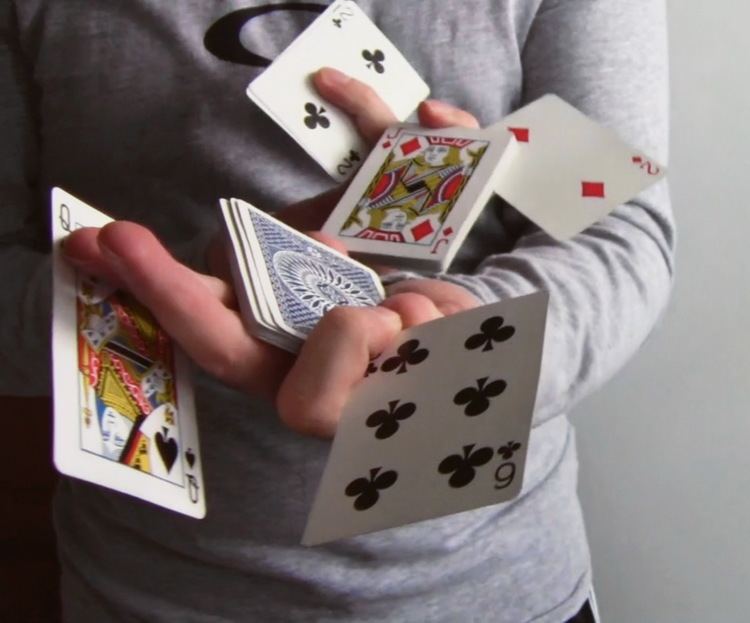 | ||
Cardistry is a name given to the performance art of card flourishing. The term is a portmanteau of "card" and "artistry". Unlike card magic, cardistry is meant to be visually impressive and appear very hard to execute. People who engage in cardistry are nicknamed "cardists".
Contents
History
Conjuring tricks with playing cards became popular around the 19th century. At that time, simple card flourishes—such as the Charlier Cut, Riffle Shuffle and Thumb Fan—were often performed by magicians as a way of demonstrating sleight of hand.
Cardistry is a portmanteau of “card” and “artistry.” It involves the use of hands to create cuts, displays, fans, patterns and sequences through the use of playing cards. Various armspreads, cuts, shuffles and springs can be used. The intent is to create a captivating motion and beautiful display. The effects are limited only by the types of cards used, the imagination, and the degree of manual dexterity of the performer. The presentation is typically neither “illusionary” nor purportedly “magic”; rather, it is more like juggling, mime, or similar entertaining activities.
American magician Chris Kenner published Totally Out of Control in 1992, an instructional book concerning magic tricks with household objects. On page 125 was a two-handed flourish he called "The Five Faces of Sybil". Making use of all fingers, the ending face of Sybil displays five distinct packets. Kenner referred to Sybil in his book as "a quick cut flourish to demonstrate skill and dexterity". The cut became the most notable creation from Totally Out of Control and would eventually form the nucleus of what is now known as cardistry. Kevin Pang of Vanity Fair magazine remarked that "every cardist can deftly perform Sybil the way guitarists can run through a blues progression".
Los Angeles-based magician Brian Tudor released an instructional VHS tape in 1997 dubbed Show Off which featured only flourishes, including numerous variations of Sybil. The tape was well received by critics and resulted in growing attention to card flourishing as a performance art.
Sybil enthusiast and twin brothers Dan and Dave released in 2001 Pasteboard Animations, another VHS tape explaining advanced cuts and flourishes. It sold hundreds of copies and was critically praised in a Genii magazine review that same year. In 2004, the twins released the instructional DVD The Dan and Dave System which officially separated advanced card flourishing from magic. Three years later in 2007, Dan and Dave released The Trilogy, a three-disc DVD set. Retailing at $85 per unit, The Trilogy is the best-selling cardistry release of all time having sold more than 25,000 copies. Virtually every cardist mention either the System or The Trilogy as the source of their inspiration.
Terminology
The different grips
One-handed cuts
Two-handed cuts
Two handed cuts are flourishes that utilize both hands.
Cuts such as the "swing" and "swivel" cut are often the first two handed cuts that beginner Cardists learn. They are essential as they provide a basis for more advanced cuts.
The Sybil Cut is the best example of a two handed multiple packet cut, originally performed by Chris Kenner. It has provided the foundation for most two handed cuts that are being developed today. It is among the most well known and recognised flourishes ever created with many artists using it to develop their own flourishes and variations.
The Squeeze cut by Daren Yeow is another good example of a two-handed multiple packet cut. It uses the scissor cut and has become a 'mainstream' move, a 'classic' and is one of the moves that can be considered as a basis for other card flourishes.
There are many different concepts developed to improve the variety of two-handed cuts:
